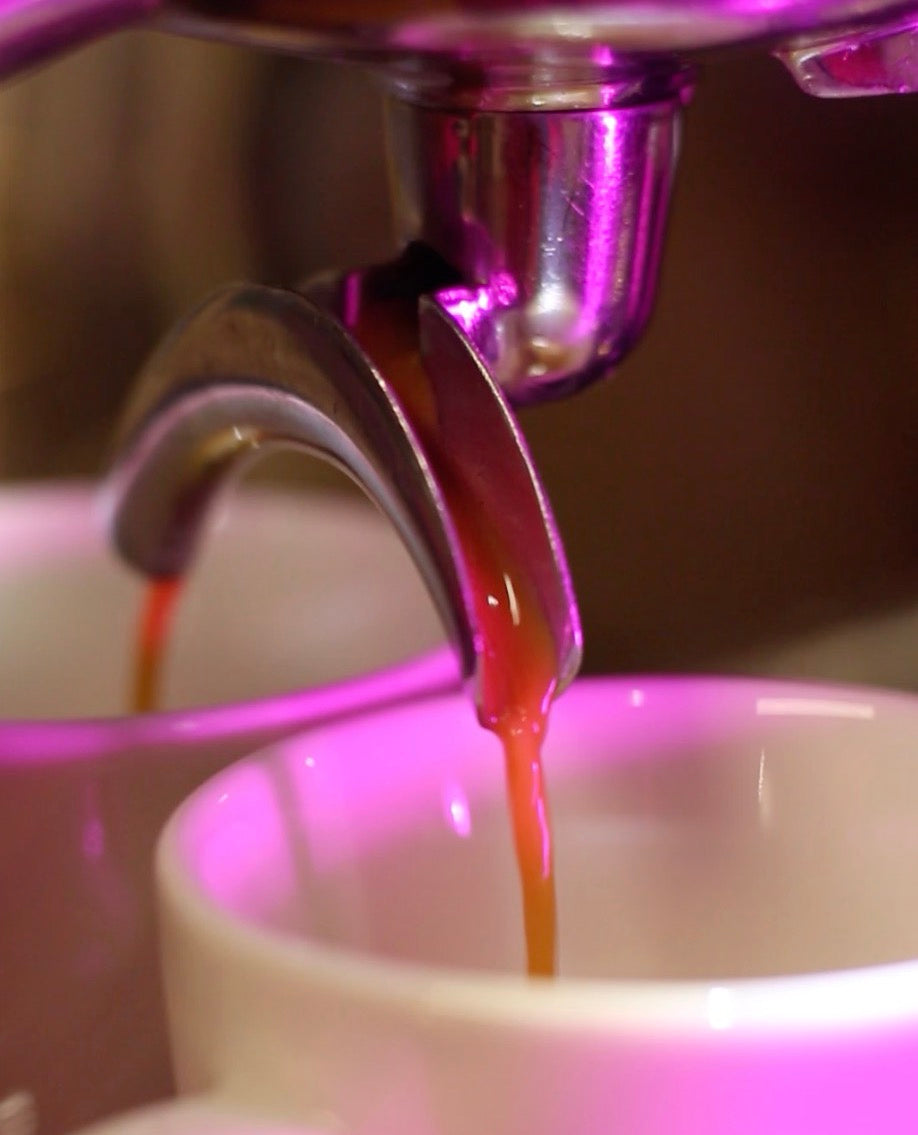Coffee Information
This coffee, produced by Alto Bonito in Tolima, Colombia, was frozen for over a year at around -30°C and is a selected batch of washed Gesha peaberries *.
We decided to do something different (and crazy) with this coffee. Consulting our ideas notebook, we proceeded to subject this coffee to a fermentation environment for 240 hours, using cold-distilled watermelon juice kombucha, which we made ourselves.
It all started with the juice of a whole watermelon, squeezed by hand. Then, we froze the juice and cold distilled it until it reached 200% of the initial concentration. Then, the juice was introduced into a vessel with a SCOBY (symbiotic culture of bacteria and yeast), which I used to produce kombucha frequently. This culture was acclimated for years, especially to ferment high-sugar substances very quickly—in a couple of days, as opposed to the normal time of 7 to 10 days for a reference SCOBY.
After 72 hours of fermentation, the coffee was introduced into the kombucha and remained there for 240 hours, with daily monitoring of temperature and pH.
After fermentation, the coffee was separated from the liquid and rinsed 3 times with purified water. It was then dried in a dehydrator set at 40°C for 3 days, with daily checks.
This is a coffee that at first does not seem like coffee, but rather an infusion of fruit and spices.
* Peaberry , or caracolillo, is when a coffee cherry has not two, but only one seed inside. It is characterized by a rounder shape and, commonly, a smaller size than normal seeds.
Producer: Alto Bonito .
Country: Colombia.
Region: Tolima.
Altitude: 1750 mts.
Variety: Gesha.
Post-harvest process: Controlled fermentation in an anaerobic environment and washing, drying on parchment, and subjected to a kombucha fermentation environment from cold distilled watermelon juice.
Harvest: 2021-2022.

(Photograph obtained from Café Alto Bonito )
Sensory Description
Grapefruit peel, blackberry, pineapple tepache, violet, miso, sumac and whole grain rye bread.
Complex medium-high acidity, medium-high candied sweetness and low spicy bitterness.
Medium body, velvety texture and persistent finish.
Import
This coffee was purchased from Café Alto Bonito , who produced and imported it to Chile. The final cost per kilo was CLP $22,000. This does not include operating costs, design or packaging —developed in conjunction with Sangre Artificial— .
Roasting
Roasting this experiment was extremely challenging, complete and utter madness. Not only was there no color feedback—coffee looks black, at virtually any degree of roast—but it was an extremely dense and elastic bean. It kept getting heat without increasing in temperature. The roaster, which normally operates on a PID that supplies power by adjusting to the bean's reaction, was completely at a loss.
However, with a little bit of cheating, and providing the toaster with a ridiculous amount of power, we were able to achieve the temperatures we needed. Kaffelogic users: Do not attempt to replicate these results.
Toaster: Kaffelogic Nano 7
Load: 90 grams
Initial humidity: 12%, rehydrated to 20%
Total time: 6 minutes, 02 seconds.
DTR: 11.5%
Final Temperature: 197.2 ºC
Accumulated Temperature*: 6.7
Mass loss: 26.3%

*We calculate this value by dividing the area under the roasting curve by the load, ([ºC x min] / grams). We consider this value, in our roaster, to be a reasonable approximation of the development of the coffee, in a broad sense.
Water
All King Solomon coffees are cupped with water that follows the recipe below, which we recommend for the best possible results. If you prefer a simpler option, we recommend using Nomadic Waters , since that is the water we commonly use.
To get to the recipe below you need to first make a couple of mineral concentrates. We used the recipes from Barista Hustle . Our water recipe aims for the highest extraction possible, and a balance between acidity, sweetness and bitterness.
Recipe:
— 185 ppm** of Magnesium Sulfate ( MgSO₄ ); that is, 185 grams of the Hardness concentrate.
— 38 ppm** of Sodium Bicarbonate ( NaHCO₃ ), that is, 38 grams of Buffer concentrate.
— 777 grams of deionized, demineralized or distilled water.
**As an equivalent in CaCO3.
To make things simpler, we will soon be launching our own bottled water, ready to use. Stay tuned!
Preparation
In general, our coffees are designed for high extractions. We recommend fine grinds, higher temperatures, and longer ratios—for filtered, between 1:20 and 1:23; for espresso, between 1:3 and 1:5. In addition, we tend to prefer relatively low concentrations, where we find the greatest clarity in descriptors.
For all of the recipes included, it is necessary to grind much finer than for other coffees. Due to the process the coffee was subjected to, the structure of the coffee remains very elastic and flexible. This means that when grinding, the production of fine particles is considerably reduced; normal grinds produce a flow that is too fast.
The idea of including recommended recipes is not to prevent you from experimenting with coffee, but to share the recipes with which we have had good results.
In this case, we are not including an espresso recipe. This is because it behaves in such a different way that it is not possible to achieve similar parameters with any other coffee. Therefore, we consider it would be irresponsible to recommend a recipe for this method.
Manual percolation coffee makers ( conical or flat bottom, such as V60, Origami, Kalita Wave, Kono, etc.)
Dose: 10 grams.
Water: 160 grams.
Drink: 140-150 grams.
Time : 2 - 3 minutes.
Temperature: Boiling; 97ºC in Santiago.
TDS: 1.2 - 1.3%.
First discharge — saturation or bloom — 40 grams, swirl the coffee maker for 5 seconds ensuring all the coffee is wet.
Second pour of 40 grams (80) at 60 seconds. Move the coffee maker gently in circles for 2 seconds.
Third pour of 40 grams (120) at 2 minutes. Move the coffee maker gently in circles for 2 seconds.
Final pour of 40 grams (160) at 3 minutes. Move the coffee maker gently in circles for 2 seconds.
It is recommended to grind finer than you think. A moka pot grind will behave like a V60 grind. At the same time, grinding will require more force than normal. Try to make all pours from as high a height as possible that does not break the flow or create bumps on the surface of the water, in a circular motion over the coffee and maintaining a controlled flow. Also, it is recommended to keep the water boiling between pours.
Immersion coffee makers (such as AeroPress, French Press, Hario Switch, Clever, etc.)
Dose: 10 grams.
Water: 160 grams.
Drink: 140-150 grams.
Time: 8 - 9 minutes.
Temperature: Boiling; 97ºC in Santiago
TDS: 1.3 - 1.4%
[AeroPress, standard method]
Pour the 160 grams of water over the coffee, trying to pour as quickly and from as high as possible so as not to create any bumps on the surface of the water. Stir carefully, making sure to wet all the coffee evenly.
Insert the plunger without applying pressure to create a vacuum.
At 7 1/2 minutes, with the plunger still inserted, gently move the pot in a circular motion for 5 seconds.
At 8 minutes, begin pressing the plunger very gently for 30 to 60 seconds; press all the way down.
For other immersion coffee makers, use the same proportions and start filtering after 8 minutes. For a French press, leave the filter at the level of the drink's surface, do not press all the way to the bottom and pour gently.
It is recommended to grind finer than you think. A moka pot grind will behave like a V60 grind. At the same time, grinding will require more force than normal. It is recommended to use the finest grind that still allows you to press the plunger smoothly.
Zero Bypass Coffee Makers (Tricolate and Next Level Brewer)
Dose: 10 grams.
Water: 180 grams, recipe included.
Drink: 160 - 170 grams.
Time: 2-3 minutes.
Temperature: Boiling; 97ºC in Santiago
TDS: 1.3 - 1.5%
[Tricolate]
First pour —saturation or bloom— of 30 grams, move the coffee maker for 10 seconds ensuring that all the coffee is wet or stir carefully with WDT tool.
Second pour of 75 grams (105) at 60 seconds. Move the coffee maker gently in circles for 3 seconds.
Third pour of 75 grams (180) when the water level from the first pour is ~1 cm from the coffee. Move the coffee maker gently in circles for 3 seconds.
For the Next Level LVL-10, use 30 grams of coffee to 600 grams of water with the same grind. For other zero-bypass coffee makers, maintain the proportions but use the dosage recommended by the manufacturer.
It is recommended to grind finer than you think. An Italian coffee maker grind will behave like a V60 grind. At the same time, grinding will require more force than normal. Also, it is recommended to keep the water boiling between pours.
Music
All of our coffees also come with a Spotify playlist, featuring songs we like to listen to while brewing and drinking. Generally, the songs we include in each playlist relate to some sensory aspect of coffee; but explaining exactly how they relate goes beyond words.
Listen to Kombu-Watermelon on Spotify.


